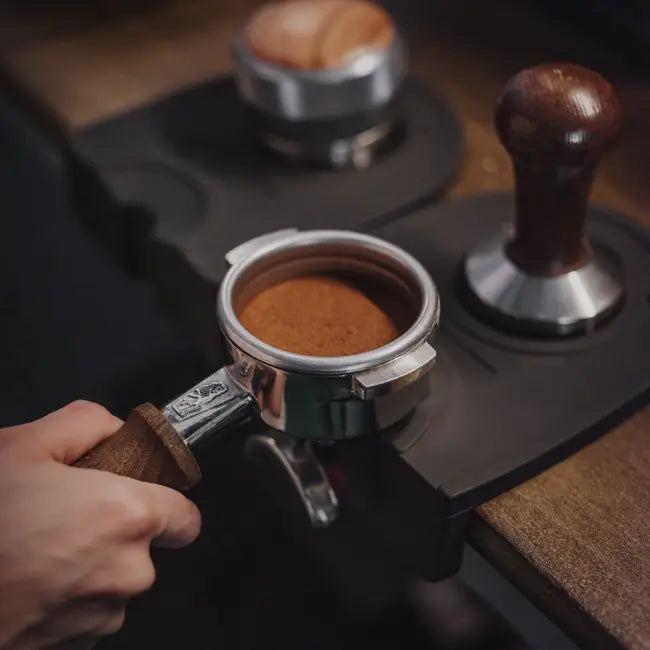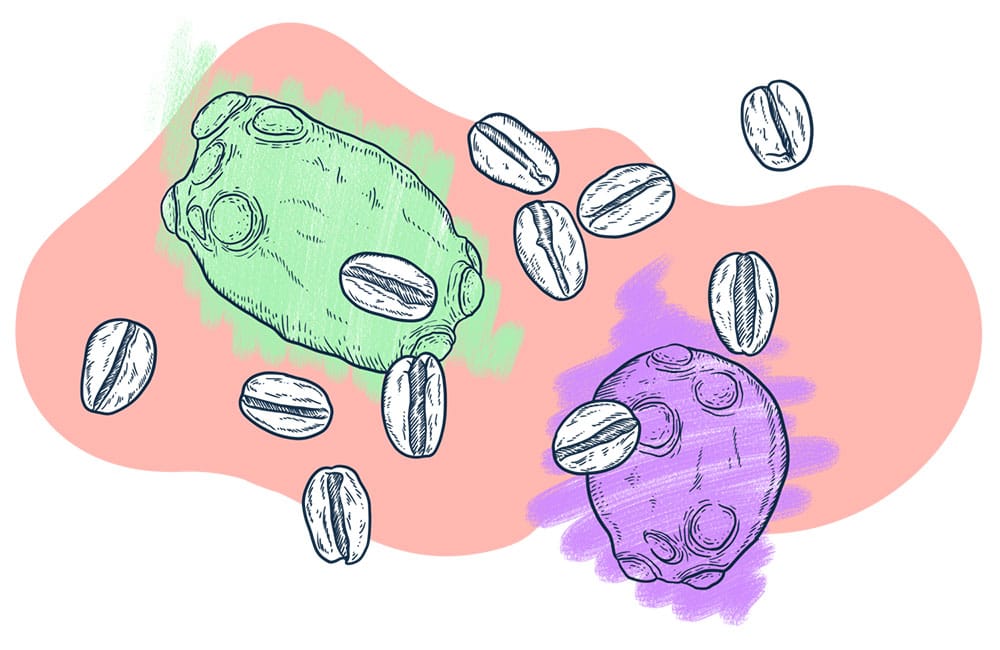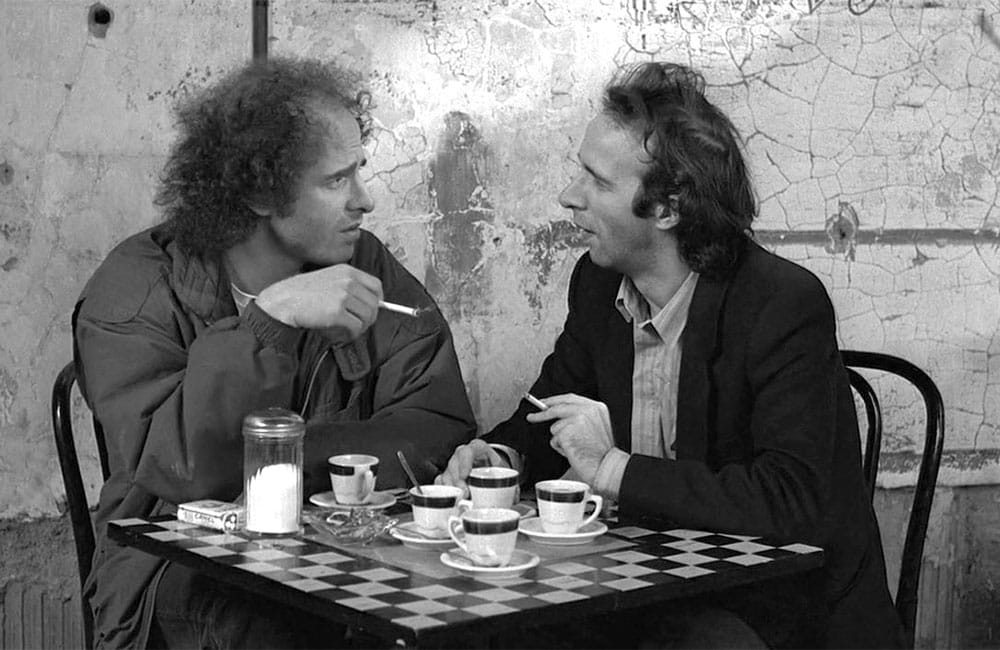Fermentación anaeróbica del café
¿Sabías que tus músculos fermentan? Bueno, que quizás deberían fermentar. Cuando haces ejercicio de una forma muy intensa (del que al día siguiente te da agujetas) tus músculos producen ácido láctico.
El ácido láctico es producido por glucólisis: degradación de los carbohidratos a ácidos por un proceso de fermentación.
Es la acumulación de este ácido lo que crea las molestias características de las agujetas.
En cierta manera, todo fermenta, pero no significa que la fermentación sea algo malo.
La fermentación puede usarse como un proceso de conservación que lleva siglos utilizándose en cocina como forma de preservación de los alimentos y que, además, hace que cambie el perfil organoléptico de los mismos.
Lo mismo ocurre con un café de especialdiad. La fermentación anaeróbica del café es un proceso por el cual se trata de crear y controlar un perfil de sabor que enriquezca sus cualidades originales.
Qué es la fermentación
 Diagrama del proceso de fermentación láctica. Foto Khan Academy. Wikipedia dice que la fermentación es: un proceso catabólico de oxidación incompleta, que no requiere oxígeno, y cuyo producto final es un compuesto orgánico. Es propio del metabolismo de muchos microorganismos y según los productos finales, existen diversos tipos de fermentación.
Diagrama del proceso de fermentación láctica. Foto Khan Academy. Wikipedia dice que la fermentación es: un proceso catabólico de oxidación incompleta, que no requiere oxígeno, y cuyo producto final es un compuesto orgánico. Es propio del metabolismo de muchos microorganismos y según los productos finales, existen diversos tipos de fermentación.
Si esto te ha sonado a chino, a nosotros también la primera vez que lo leímos, pero vamos a intentar simplificarlo (bajo pena de perder exactitud).
Louis Pasteur, a quien se le atribuye haber descubierto este proceso, lo describía como la vie sans l'air (la vida sin aire).+
Una forma muy poética de decir que existen ciertos microorganismos (como las bacterias) que transforman moléculas complejas en moléculas sencillas y generan energía química; de esta forma pueden seguir viviendo y se desarrollan sin necesidad de oxígeno.
La molécula que se transforma es la molécula de la glucosa y el proceso se llama glucólisis. Ahora piensa ¿qué no contiene algún tipo de glucosa? Prácticamente nada, por lo que todo es susceptible de fermentarse.
La fermentación es un proceso de oxidación no completado (de la oxidación del café hablamos en este post) puesto que la proliferación de los microorganismos responsables de la glucólisis hace que otros microorganismos no se reproduzcan y no se complete el proceso de oxidación.
Fermentación en la cocina
Ahora bien, ¿qué significa la fermentación en el mundo culinario? Y de forma más específica ¿qué significa la fermentación anaeróbica del café?
La cocina escapa un poco de la definición científica de la fermentación y la hace extensible a varios procesos similares.
En cocina, la fermentación es la transformación de determinados elementos orgánicos de los alimentos debido a la acción de levaduras o bacterias.
Los microorganismos que se encargan de la fermentación pueden encontrarse de manera natural en los alimentos o pueden ser añadidos para crear la reacción deseada.
Esto resulta en la formación de ácidos o alcoholes (por ejemplo, yogur o vino). El tipo de fermentación es diferente dependiendo del alimento, el fermento y el tiempo.
La fermentación es una forma de conservar los alimentos (por ejemplo, los encurtidos), cambiar su perfil organoléptico (por ejemplo, el vino) y de mejorar el valor nutritivo y la eficacia de las proteínas (por ejemplo, el yogur).
Toda fermentación es anaeróbica
 Rodolfo Rufatti en la Finca El Salvador, de donde son nuestros cafés de fermentación anaeróbica de 48 y 120 horas Hablar de fermentación anaeróbica del café es una redundancia puesto que toda fermentación es, técnicamente, anaeróbica. Es decir, los microorganismos que se encargan de que las moléculas de glucosas se descompongan en otras más simples siempre actúan en ausencia de oxígeno.
Rodolfo Rufatti en la Finca El Salvador, de donde son nuestros cafés de fermentación anaeróbica de 48 y 120 horas Hablar de fermentación anaeróbica del café es una redundancia puesto que toda fermentación es, técnicamente, anaeróbica. Es decir, los microorganismos que se encargan de que las moléculas de glucosas se descompongan en otras más simples siempre actúan en ausencia de oxígeno.
Pero que sea una redundancia no significa que no tenga sentido hablar de ella en el contexto de los procesos del café.
Rodolfo Ruffatti, nuestro colaborador de trato directo de la Finca El Salvador, hablando sobre los cafés de fermentación anaeróbica, nos dijo que: “La fermentación anaeróbica ya se estaba haciendo desde hace un tiempo sin que nadie le pusiera un nombre. Fue Sasa Sestic, en el World Barista, quien empezó a dar a conocer este método cuando dijo que el café con el que ganó era de maceración carbónica. Hay gente que no quiere usar el término ‘anaeróbico’ por que todas las fermentaciones los son”.
La razón por la que hablamos de fermentación anaeróbica del café es para diferenciar los cafés que se han expuesto a un proceso de fermentación extendido, generalmente en tanques sellados, del resto de cafés, puesto que todos los cafés sufren un proceso de fermentación en mayor o menor medida.
Fermentación del café
El proceso de fermentación empieza tan pronto como se recolectan las cerezas de café. Luego, dependiendo del procesado que se utilice para separar la semilla de la cereza (el despulpado), el proceso de fermentación será más largo o corto.
La fermentación es más larga en un proceso lavado en el cual se busca a propósito un punto de fermentación (despulpado, fermentado, lavado y secado) que un proceso de semi-lavado (despulpado y secado).
En un café con fermentación anaeróbica, el café, ya sea con pulpa o solo con el mucilago, se deja fermentar durante un número determinado de horas en un tanque sellado para que no entre oxígeno.
Por lo tanto, podríamos decir que la definición de fermentación anaeróbica de un café, aunque técnicamente redundante, cumple una función diferenciadora. Además, existen varios tipos de denominaciones para diferentes métodos de fermentación. Estos son:
- Anaeróbica
- Carbónica
- Láctica
- Otros procesos experimentales
Veamos qué significa cada uno y cómo afecta al café.
Fermentación anaeróbica
 Semillas de café durante proceso de fermentación anaeróbica. Foto: https://www.sabores.co.za/ Como hemos dicho, toda fermentación es anaeróbica. Pero cuando usamos el término fermentación anaeróbica para un café nos referimos a que este ha sido dejado fermentar en un tanque sellado para que no entre oxígeno, pero con una válvula unidireccional para que pueda ser expulsado.
Semillas de café durante proceso de fermentación anaeróbica. Foto: https://www.sabores.co.za/ Como hemos dicho, toda fermentación es anaeróbica. Pero cuando usamos el término fermentación anaeróbica para un café nos referimos a que este ha sido dejado fermentar en un tanque sellado para que no entre oxígeno, pero con una válvula unidireccional para que pueda ser expulsado.
La temperatura del tanque también se suele controlar para un resultado más preciso.
Rodolfo Ruffatti, en una de nuestras conversaciones, nos comenta que “este proceso puede hacerse con tanque, con barriles, incluso con bolsas de plástico Grain-pro. Lo importante es que pase un tiempo sellado sin acceso al aire”.
Esto se puede hacer antes de que se despulpen las cerezas o bien una vez han sido despulpadas. En ambos casos, los microorganismos comenzarán a romper las moléculas de glucosa, una reacción química que genera CO2 y calor.
Esto hará que se desplace el oxígeno en el tanque y sea expulsado por la válvula unidireccional.
Las bacterias que se encuentran de forma natural en la cereza de café y en el mucílago producen enzimas durante este proceso, que son las que hacen que se generen compuestos menos complejos, como ácidos orgánicos y alcohol.
Por qué se utiliza y cómo influye la fermentación anaeróbica en el café
Como hemos dicho, todo café sufre un proceso de fermentación, generalmente breve, una vez es recolectado. Este proceso de fermentación, que en algunos tipos de procesados como el honey o natural se extiende adrede, forma parte del perfil característico del sabor de cada café.
Pero, a pesar de ser una parte integral del perfil del sabor del café, es un proceso que no se llegaba a controlar del todo. La fermentación anaeróbica del café permite controlar este proceso.
Esto se hace controlando el Ph, con una lectura del Brix (indicación del contenido de azúcar) y controlando la temperatura en el interior del tanque.
El resultado de controlar y alargar la fermentación del café es que se altera su composición química y por tanto su perfil organoléptico.
La fermentación puede hacer que se potencien los sabores o que se creen diferentes perfiles de un mismo café. Por ejemplo, un café con una fermentación de 48 horas no será igual que el mismo café con una fermentación de 120 horas.
Cafés de fermentación anaeróbica en Ineffable Coffee
En Ineffable Coffee tenemos varios cafés de fermentación anaeróbica, como el de fermentación corta (48 horas) y otro de fermentación larga (120 horas) que puedes probar para apreciar las diferencias.
Ambos de la Finca El Salvador y de trato directo con nuestro colaborador en El Salvador, Rodolfo Ruffatti.
La Dra. Britta Folmer en su libro The Craft and Science of Coffee, dice que “[eliminar el mucílago a través de] la fermentación bajo el agua se dice que resalta la acidez y el aroma, y descarta cierta astringencia”.
Aunque una fermentación demasiado larga puede tener el efecto contrario, se pierde acidez, cuerpo y aroma.
Los productores buscan encontrar un equilibrio en el que se potencie el sabor y aroma sin llegar a que el café empiece a perder propiedades.
Maceración carbónica
 Diagrama del proceso de maceración carbónica. Imagen: Sassa Sestic La química básica de la maceración carbónica del café es la misma que la de la fermentación anaeróbica, puesto que es un proceso de fermentación, pero bajo condiciones diferentes.
Diagrama del proceso de maceración carbónica. Imagen: Sassa Sestic La química básica de la maceración carbónica del café es la misma que la de la fermentación anaeróbica, puesto que es un proceso de fermentación, pero bajo condiciones diferentes.
La diferencia radica en que, en la maceración carbónica, una vez las cerezas de café han sido introducidas en el tanque sellado, a este se le inyecta dióxido de carbono que expulsa todo el oxígeno del tanque.
Por esta razón se la llama “carbónica”.
El proceso de maceración carbónica
En el proceso de fermentación por maceración carbónica las cerezas de café son introducidas en un tanque sellado con una válvula unidireccional. Luego se inyecta dióxido de carbono que hace que todo el oxígeno sea expulsado del tanque.
La duración de la maceración depende de lo que quiera conseguir el caficultor, pero puede ir de unas horas a varios días. Al igual que en la fermentación anaeróbica, es importante controlar la temperatura, el pH y el nivel azúcar (Brix).
Las cerezas pueden ser introducidas en el tanque enteras o pueden haberse despulpado previamente.
Para obtener un café “lavado” se introducirán las cerezas despulpadas mientras que para un café “natural” se introducirán sin despulpar y posteriormente se dejan en secar en camas africanas.
Por qué se utiliza y cómo influye la maceración carbónica en el café
La razón por la que se utiliza la maceración carbónica, en lugar de la fermentación anaeróbica, es porque al inyectar en el tanque dióxido de carbono y sacar todo el oxígeno se ralentiza el proceso de fermentación.
Al no haber oxígeno (por lo tanto, no hay oxidación) la descomposición de la glucosa es más lenta, así como la evolución del pH. Además, controlando los diferentes parámetros se pueden obtener diferentes resultados.
Sasa Sestic, campeón del mundo barista y pionero en aplicar este proceso de maceración procedente del vino al café, dice que controlando la temperatura se puede controlar tanto la acidez como la dulzura.
A temperaturas bajas se potencia la acidez mientras que a temperaturas altas se potencia la dulzura.
Como con la fermentación anaeróbica, se busca mejorar la presentación en taza del café potenciando el aroma, mejorando la dulzura y la acidez y obteniendo un café con más cuerpo.
Disfruta del café de temporada, visita nuestra tienda
Proceso láctico de fermentación y otros procesos experimentales
 Se esta experimentando con procesos de fermentación alternativas, como el de la Kombucha, en el café. Foto: Tim Oliver MetzLa fermentación anaeróbica del café y la maceración carbónica son los dos procesos más comunes actualmente para potenciar las cualidades organolépticas de un café, pero no son los únicos.
Se esta experimentando con procesos de fermentación alternativas, como el de la Kombucha, en el café. Foto: Tim Oliver MetzLa fermentación anaeróbica del café y la maceración carbónica son los dos procesos más comunes actualmente para potenciar las cualidades organolépticas de un café, pero no son los únicos.
Existen otros procesos, algunos en fases más experimentales que otros, para alcanzar estos resultados.
Podemos hablar de fermentación láctica, con la bacterias del hongo de la kombucha y con la del kéfir de agua.
El café tiene diferentes bacterias que son las que llevan a cabo el proceso de fermentación, entre ellas se encuentran las bacterias de ácido láctico. Estas son las mismas que llevan a cabo los procesos de fermentación en los lácteos.
En el proceso de fermentación láctica del café se facilitan las condiciones, a través de la regulación del oxígeno, por ejemplo, para que proliferen estas bacterias y no otras (como las bacterias aeróbicas).
Esto hace que el proceso de fermentación sea diferente y se puedan obtener diferentes resultados.
Procesos experimentales
Algunos procesos experimentales están tratando de introducir la bacteria que se encarga de la fermentación en el hongo de la kombucha y el kéfir al proceso de fermentación del café.
Una forma de hacer esto es dejando que las cerezas de café fermenten en el líquido de la kombucha o el kéfir de agua en lugar de simplemente agua.
La razón de esta experimentación es ampliar el horizonte de notas de cata, de acidez, de dulzura, de cuerpo en la taza, etc.
Y esto es algo muy excitante, abre un nuevo mundo de posibilidades.
Equípate con nuestros complementos, visita nuestra tienda
¿Hacia dónde van los procesos del café?
 Cafes con fermentación anaeróbica de 48 y 120 horas de Ineffable Coffee Como hemos visto en este breve repaso por los diferentes tipos de fermentación del café, los procesos del café están madurando, se están haciendo adultos y están aprendiendo de otras industrias como la del vino o las cervezas, donde el proceso de fermentación es una parte indispensable y crítica.
Cafes con fermentación anaeróbica de 48 y 120 horas de Ineffable Coffee Como hemos visto en este breve repaso por los diferentes tipos de fermentación del café, los procesos del café están madurando, se están haciendo adultos y están aprendiendo de otras industrias como la del vino o las cervezas, donde el proceso de fermentación es una parte indispensable y crítica.
Quizás no todos los procesos y experimentaciones tengan resultados positivos, algunos se quedarán y otros nos dejarán. Quizás haya algunos cafés que sea preferible continuar procesándolos por los medios tradicionales.
Pero todo esto se traducirá en un excitante viaje sensorial y mejora de nuestra experiencia al tomar café. Y puede que estos procesos e innovaciones nos lleven a lugares únicos y desconocidos hasta ahora para el mundo del café.
Nosotros tenemos muchas ganas de formar parte de este viaje y por eso hemos incluido en nuestra selección dos cafés de fermentación anaeróbica y trato directo de la Finca El Salvador que son el resultado del trabajo del equipo de Productor Coffee bajo la dirección de Rodolfo Ruffatti: uno de 48 horas, con sutiles notas frutales, y otro de 120 horas, donde la intensidad de los sabores se magnifica.
¿Y tú, vienes con nosotros?








